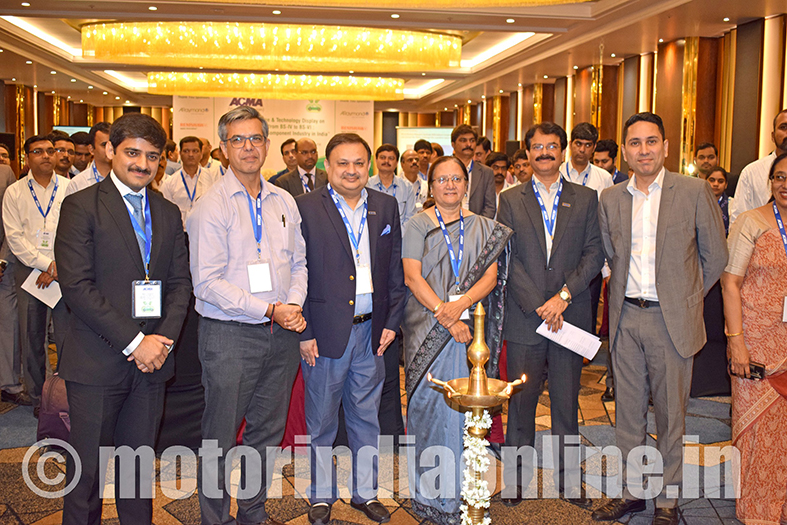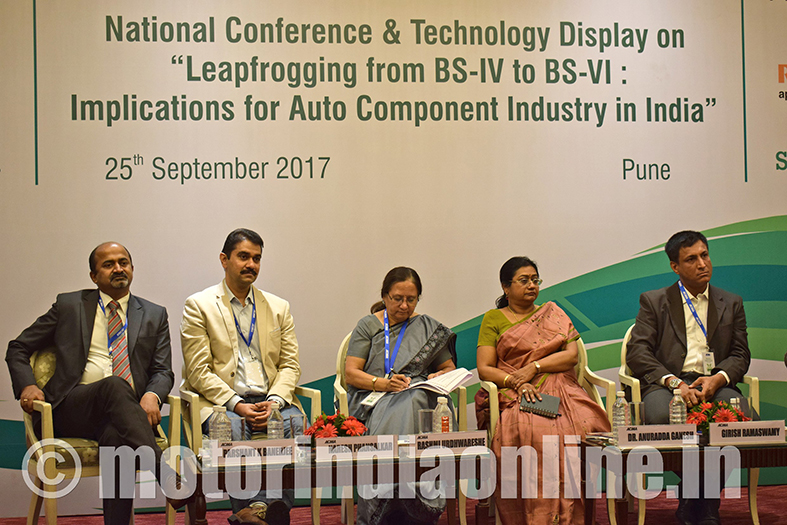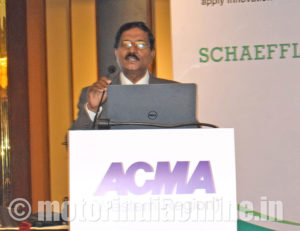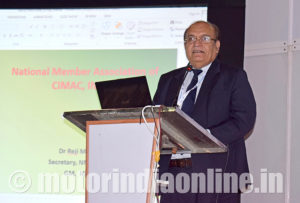While the automotive industry has begun to settle with the implementation of the nation-wide BS-IV emission norms, it is not far away from the imminent challenge of leapfrogging to the BS-VI emission norms. With just over 24 months before the nation-wide BS-VI regulation, ACMA (western region) organized a National Conference on the subject for the industry peers in Pune. The event was attended by Mr. Vinnie Mehta, Director-General, ACMA, Mrs. Rashmi Urdhwareshe, Director, ARAI, Mr. Piyush Tamboli, Chairman – Western Region, ACMA, and CMD, Investment & Precision Castings Ltd., Mr. Ashim Sharma, Partner & Division Head, Business Performance Improvement Consulting, Nomura Research Institute India Pvt. Ltd., and many industry leaders.

In the first address of the day, Mr. Ashim Sharma said: “We all know it is going to be much more stringent when it comes to reduction in particulate matter and NOx in the BS-VI regime. Elimination of particulate matter would help remove smog. In BS-VI, the air coming out of the tail pipe will be a lot cleaner than the air currently. All automobiles will have to go through this change.”
Getting into action
The speakers agreed that engine fitments typically required for upgradation to the BS-VI norms from the BS-IV norms would-be diesel particulate filter (DPF) for reduction of PM in diesel vehicles and selective catalytic reduction (SCR) module and exhaust gas re-circulation (EGR), which is for NOx reduction. SCR is a process that uses a catalyst to convert NOx in exhaust gases into nitrogen and water, which are then released into the air.
In EGR, the engine recirculates a portion of the exhaust gas back to the engine cylinders depriving it of certain amount of oxygen, thereby leading to lower temperature burn. This reduces NOx emissions, but produces more PM, which is reduced using diesel oxidation catalyst (DOC) and particulate filter.

Either of the combination is believed to reduce the particulate matter to 82 per cent and NOx by 68 per cent. DPF, a device designed to remove diesel particulate matter, or soot, from the exhaust gas of a diesel engine. OEMs will have to invest over the next 24 months in line with the market demand. This will mean building capacities for DPF and SCR modules. “While the auto component makers have to meet the Indian conditions while choosing the right option, one cannot overlook the need for an integrated approach to achieve the emission norms,” added Mrs Urdhwareshe.
Adoption to Indian requirements
Although the companies in India which have had global experience in Europe offer the technology here (like Tenneco), the testing, optimisation and fitment of DPF and SCR technology to Indian conditions will take a few years. “It is not possible to simply plug and play with the European technology (compliant with the Euro-VI norms) here in India. There would be a lot of design and re-engineering required,” said Naresh Phansalkar, Director Engineering, Clean Air, Tenneco.

Expressing his views on the transition for the entire automotive sector, Mr. Prashant Banerjee, Dy. Executive Director (Technical), SIAM, said: “BS-VI transition will need RON 95 (octane rating fuel) as opposed to RON 91 in gasoline. The higher the octane number, the more compression the fuel can withstand before detonating (igniting). In broad terms, fuels with a higher-octane rating are used in high performance gasoline engines that require higher compression ratios. Reference fuel in India is E5 as compared to E10 in Europe. E10 blends are typically rated as being 2 to 3 octane numbers higher than regular gasoline. We will also be the first, even before Europe to implement BS-VI for two-wheelers in India. Our country will face challenges with lab test vs. road test. We need at least 160,000 km of emission testing before the standards are implemented.”
Most of the speakers agreed that the challenge, apart from the technology, is the timing required for the application of solutions at effective costs. “Although the date given for the nation-wide implementation is April 2020, the technology has to be made available 6 to 8 months in advance. There is no scope for failure, everybody (auto component manufacturers and OEMs) will have to be first time correct,” asserted Mr. K. Veermani, GM – Power Systems Engineering Division, Tata Motors – Engineering Research Centre.
Echoing his sentiments, Dr. Anuradda Ganesh, Director – R&D, Cummins India, remarked: “Stringent emission norms should be an opportunity for us to keep on exploring newer technologies. The Government has already assured that the right fuel will be available in India for vehicle testing cycles before 2020 even if it must import the same. We should look ahead and embrace the changing times with innovation.”
Indian refineries on track to meet BS-VI norms
In a different event known as INMEX SMM Asia’s largest Maritime Exhibition and Conference for Shipbuilding, National Member Association of CIMAC (International Council on Combustion Engines) organized CIMAC Circle to discuss the most stringent emission requirements for vessels in NOx Emission Control Areas. Different types of dedicated NOx emission control technologies were compared including exhaust gas recirculation and selective catalytic reduction. MOTORINDIA got a chance to speak to Dr. RK Malhotra, Director General, Federation of Indian Petroleum, on the sidelines of the ACMA National Conference in Pune, regarding oil refineries’ preparedness for BS-VI vehicles for auto OEMs.

He said: “Refineries have been given a road map, and they are working towards reducing the sulphur content and they are very much on track. They should be able to meet the target on the dates given to them for commercial supply. Investments are made wherever required, the refinaries are being upgraded and hydrogen augmentation facilities installed. Fuel is available for testing even today in a limited quantity and can be made available to OEMs at their dedicated pumps for testing on request. Commercial availability of fuel will only be done as per the government guidelines.”